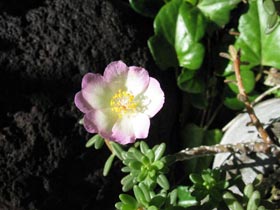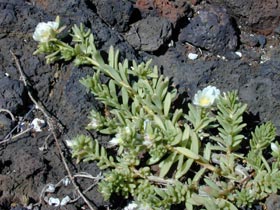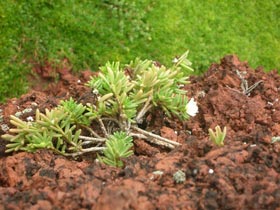Portulaca villosa
Genus
Portulaca
Species
villosa
Hawaiian Names with Diacritics
- ʻIhi
Hawaiian Names
- Ihi
Common Names
- Hairy purslane
Synonyms
- Portulaca caumii
- Portulaca hawaiiensis
- Portulaca pilosa subsp. villosa
Distribution Status
Endemic
Endangered Species Status
At Risk
Plant Form / Growth Habit
- Non-Woody, Spreading
Mature Size, Height (in feet)
- Grass-like, Short, Less than 1
- Grass-like, Medium, 1 to 2.5
Mature Size, Width
Plant is known to have a 2-foot spread.
Life Span
Long lived (Greater than 5 years)
Landscape Uses
- Accent
- Container
- Ground Cover
- Indoor
- Specimen Plant
Additional Landscape Use Information
An excellent bedding or accent plant with very good drainage. [Rick Barboza, Hui Kū Maoli Ola]
These are great potted plants for the often harsh conditions on full sun and windy porches or lānais. If kept in containers, use a 4 to 6 inch cement, terra cotta, or unglazed ceramic pots which are preferred over plastic ones. These types of potting containers tend to breath better and allow potting mix to dry out quicker, essential for the health of these xeric plants. Too, the weight of the pots will help these succulents from toppling over in windy conditions and as they grow larger in the pots. Use a very dry potting mix (i.e. cactus mix) with perfect drainage.
This species has proven to be a great indoor plant, but only if used in a very sunny window planted excellent drainage. Plant them in a perfect drainage media such as for cactus, that is with mostly free draining potting materials such as a 4:1 ratio of 4 parts perlite and/or black cinder to 1 part good potting "soil" (e.g. Sunshine #4). But as mentioned, cement or terra cotte pots are best. Keep watering very minimal. [David Eickhoff, Native Plants Hawaiʻi]
Plant Produces Flowers
Yes
Flower Type
Not Showy
Flower Colors
- Pink
- White
Additional Flower Color Information
Flowers of this species are white, pink, or pink with a white base.
Blooming Period
- Year Round
- Sporadic
Plant texture
- Fine
Leaf Colors
- Light Green
Additional Leaf Color Information
ʻIhi leaves are pale grayish green with yellowish brown hairs, hence the species name villosa meaning "hairy."
Additional Pest & Disease Information
These succulents are prone to attacks from slugs, ants, mealy bugs, scale, thrips, spider mites and aphids, and root mealy bugs. Fungal rot can be a major problem so do not let water remain on the surface. ʻIhi need well drained soil and should be watered in the morning to allow the pot to dry out during the day.
Fertilizer
An application of a balanced slow release fertilize with minor elements every 6 months. Foliar feed monthly with kelp or fish emulsion, or a water-soluble fertilizer with a dilution of one half to one third of recommended strength.
Water Requirements
- Dry
Additional Water Information
Too much water can cause ʻihi to become leggy and does not look as attractive. [Rick Barboza, Hui Kū Maoli Ola]
Soil must be well drained
Yes
Light Conditions
- Full sun
Tolerances
- Drought
- Wind
- Salt Spray
- Heat
Soils
- Sand
- Cinder
- Coral
Limitations
ʻIhi can succumb to fungal rot caused with too much moisture. Not a plant for those that ca't keep their fingers off the hose.
Natural Range
- Oʻahu
- Molokaʻi
- Lānaʻi
- Maui
- Kahoʻolawe
- Hawaiʻi
- Northwest Islands
Natural Zones (Elevation in feet, Rainfall in inches)
- Less than 150, 0 to 50 (Dry)
- 150 to 1000, 0 to 50 (Dry)
- 1000 to 1999, 0 to 50 (Dry)
Additional Habitat Information
This uncommon endemic species of ʻihi is naturally found in dry, rocky, clay, lava, or coralline reef sites from sea level to over 1,600 feet.
In the Northwest Islands it is only found on Nīhoa (Moku Manu). Interestingly, it is also found on Kaʻula, a small islet 23 miles southwest of Niʻihau, but strangely not known to naturally occur on nearby Niʻihau itself nor on Kauaʻi.
![]() Special Features and Information
Special Features and Information
General Information
ʻIhi (Portulaca spp.) are members of the Purslane family or Portulacaceae. Many, such as portulacas and lewisias, have succulent leaves and very colorful flowers that are commonly seen in home gardens.
There are four species of Portulaca native to the Hawaiian Archipelago.
Etymology
The generic name Portulaca is the Latin name for purslane (Portulaca oleracea).
The Latin specific epithet villosa, hairy, in reference to the pale grayish green leaves with yellowish brown hairs.
Additional References
[1] "Natural History of Nihoa and Necker Islands" by Neal L. Evenhuis, page 61.
PHOTOS FOR THIS SPECIES CAN BE SEEN AT THE LINK (Copy & Paste to your browser):
Portulaca villosa
https://www.flickr.com/search/?user_id=50823119%40N08&sort=date-taken-desc&view_all=1&text=Portulaca%20villosa
Portulaca sclerocarpa
https://www.flickr.com/search/?user_id=50823119%40N08&sort=date-taken-desc&view_all=1&text=Portulaca%20sclerocarpa
Plant Gallery
Back to Plant List
Other Nursery Profiles for Portulaca villosa



